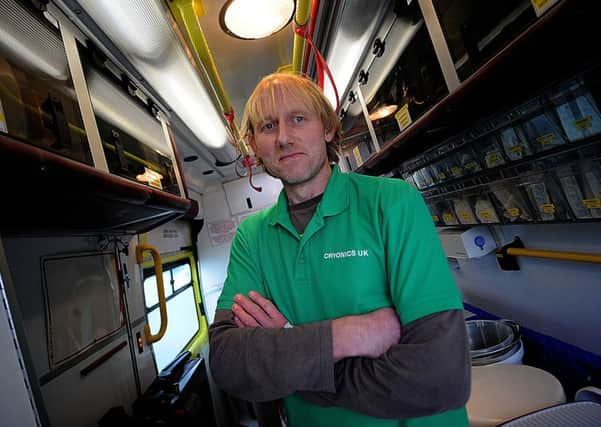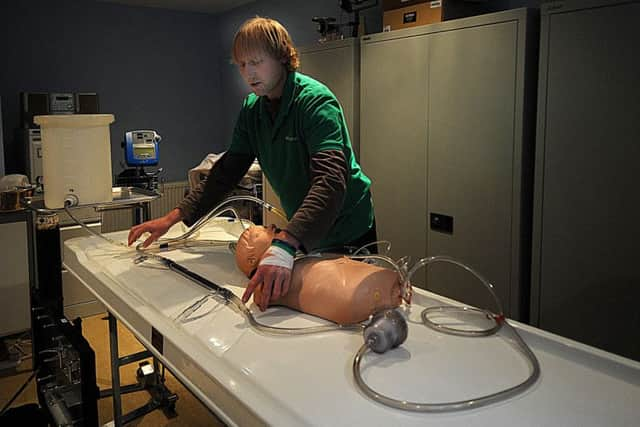Why I'm going to have my brain cryogenically frozen when I die


Tim Gibson is the man to go to if you’re looking for student accommodation in Sheffield. He’s also the man to go to if you fancy being cryogenically frozen in the hope medical science will one day find a way to bring you back to life.
The 45 year old was a teenager when he first became interested in the idea of immortality and now as a member of the Yorkshire based Cryonics UK he is permanently on standby, ready with his second hand ambulance to drive to wherever his services are needed next.
Advertisement
Hide AdAdvertisement
Hide Ad“The organisation was set up by a couple of guys in 1986,” he says. “Initially it was just a group for like-minded individuals to get together and chat about cryogenics, but quite quickly an obvious question posed itself. The main storage facilities are in America, so if you have people over here who want to end up over there then you need to be able to begin the freezing process as soon as possible after death.”


Step forward Alan Sinclair. The Brighton care home owner had already booked a place at the Alcor Life Extension Foundation in Michigan and a few years ago decided to go one step further by stumping up the cash to ensure a team in the UK had the right equipment and technical savvy to do the necessary when the end came.
Tim, who now leads various training sessions from the garage next to his home, joined Cryonics UK in 1992 and has since dealt with 10 cases, including the 14 year old whose story hit the headlines last week. Suffering from terminal cancer and supported by her mother and grandparents, the teenager wanted to be cryogenically preserved. When her father objected, the case ended up being heard in front of High Court judges who ultimately ruled in her favour.
“Of course the first time I saw a dead body I felt uncomfortable,” says Tim. “Whatever people think of us, we are in fact normal human beings, but the more you do it, the more you get used to it. Quite quickly I stopped seeing them as a dead person and now I think of them as a patient, someone who at some point in the future may have a viable chance of life again.
Advertisement
Hide AdAdvertisement
Hide Ad“One time I sat with a guy in hospital for a week. Most of the time he was knocked out on diamorphine but we did talk a little. When you see someone take their last breath, they’re not just a body to you, we absolutely treat them with care and respect.”


So far 126 people have registered official interest with Cryonics UK and as soon as the team hears one of them is nearing the end, then Tim and the other volunteers move in.
“Timing is everything. If we know someone is dying then we will get our ambulance ready and go wait outside the hospital or their home. Some doctors are supportive of what we do, others less so, but this has to be about individual choice.”
One of the criticisms levelled at Cryonics UK is that it’s staffed by enthusiastic amateurs who have taken to playing God. Tim doesn’t have any official medical qualifications, but while all of his initial training was done on mannequins he insists that the organisation is run with the highest levels of professionalism
Advertisement
Hide AdAdvertisement
Hide Ad“We all know what we are doing. Immediately after death, the body has to be put on a cardiac support machine, which allows the heart to keep pumping,” he says. “Then we inject various drugs to stabilise the individual’s biochemistry which goes absolutely haywire. After that, the next job is to cool the body.
“It takes between two and three hours to bring a cadaver down to 10C and it’s only at that point that we can wash out the blood. That can take up to 12 hours and we then replace it with a chemical mix which effectively removes the water from the cells and prevents ice crystals from forming.
“Afterwards we put the corpse into dry ice with the aim of lowering the temperature to -70C. That usually takes three to four days, but this is something you can’t rush. If you dropped the body straight into liquid nitrogen it might be cold on the outside, but it would still be warm on the inside and you don’t want that.”
Tim says the organisation has never been busier. Normally they receive about 20 enquiries a year, but last week they had that same number in just two days. For most, thoughts of being cryogenically frozen, will remain just that, but a minority will book themselves a place in frozen storage.
Advertisement
Hide AdAdvertisement
Hide Ad“When I was really young, I was scared of dying and I think that’s where it all began. I thought a lot about the idea of being brought back to life, but I didn’t think it was feasible. Then as I got older I realised that may be there was a way.”
Tim originally took out a life insurance policy which on death would pay for his entire body to be frozen. However, he has since altered the particulars.
“I’m now just going to have my head frozen,” he says. “I mean why would you want to wake up with an 80 year old body? I think I’d much rather have someone build me a new one.
“I know that a lot of people think that this is pie in the sky, but I just don’t understand why. They can now print sections of human body parts, they’ve grown an ear on the back of a mouse, so who knows what developments will be made in 50 or 100 years time?
Advertisement
Hide AdAdvertisement
Hide Ad“A couple of hundred years ago, if you stopped breathing, they buried you. As recently as the 1950s, if your heart stopped, you’d be cremated. These days, it’s more likely you’ll be resuscitated and sent back to work to pay your taxes.”
Currently cryonics goes unregulated in the UK. However, the Department of Health has said it will be conducting a review after concerns were raised about Cryonics UK during last week’s court case. The trust of the hospital where the teenager died also claimed its members were “under-equipped and disorganised” when they arrived to prepare the girl’s body.
“A lot of people can’t get their head around it, including my dad,” says Tim. “When I told him what I was planning to do he came out with all sorts of nonsense about it being immoral. It’s only immoral if you think giving people heart and lung transplants is immoral. I don’t know why, but there are a certain group of people who think that living longer is bad. I don’t get it.”
There have also been claims that it’s an industry which preys on the vulnerable and one which is fuelled by science fiction rather than medical facts.
Advertisement
Hide AdAdvertisement
Hide Ad“Go onto any reputable cryonics website and you will see not one of them will offer any guarantees,” says Tim. “When anyone approaches us we are very deliberately hands off. We will give out information and point them in the right direction of people they might want to talk to, but we are the very opposite of pushy.
“People often ask me, how do I think I would feel if I woke up in a strange world where I didn’t know a single person. Well, I don’t know, but I do know that this is about having a shot of life. The alternative is certain death.”